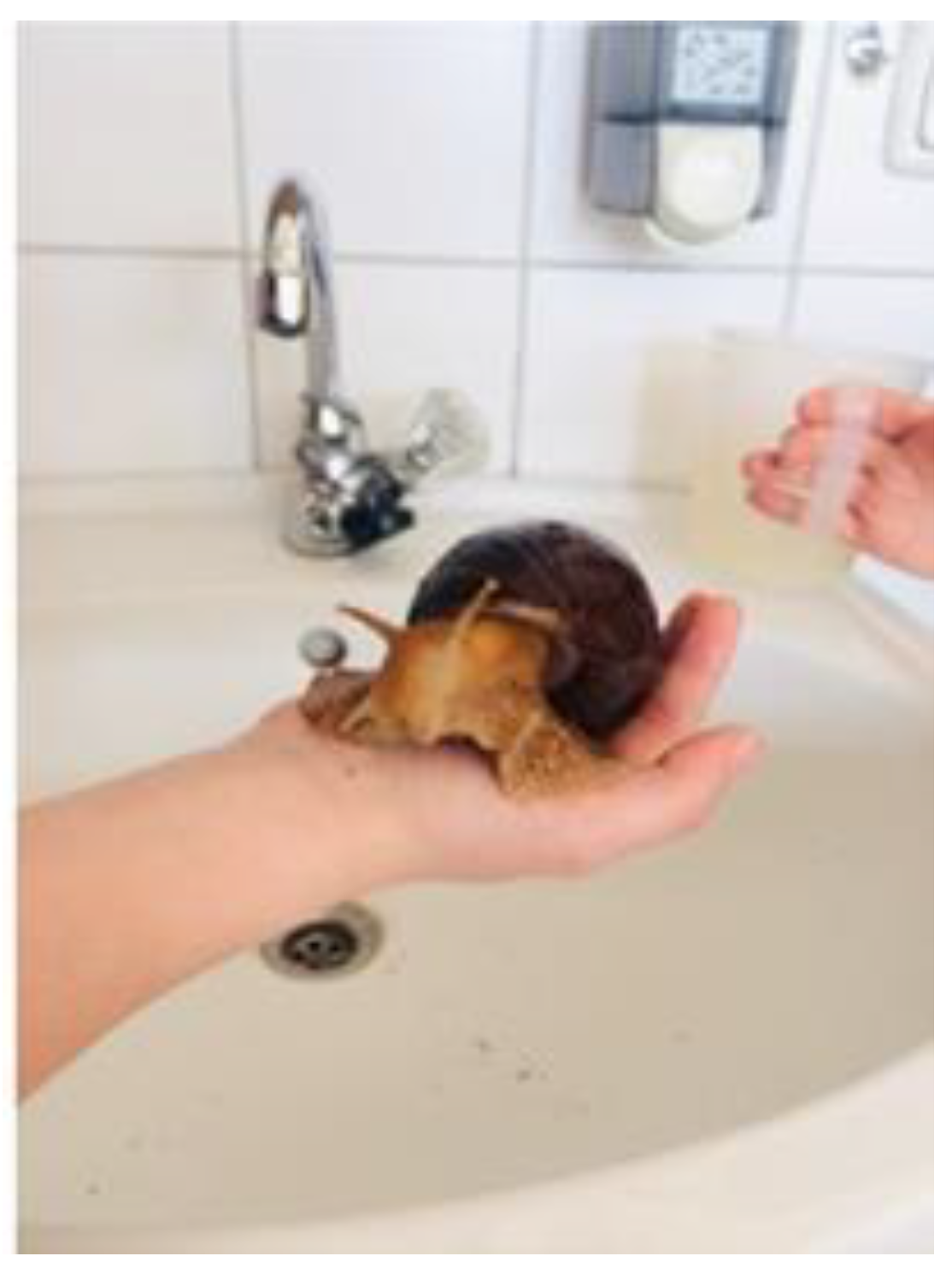Children’s Relationships with a Non-Vertebrate Animal: The Case of a Giant African Land Snail (Achatina fulica) at School
Abstract
Simple Summary
Abstract
1. Introduction
2. Materials and Methods
2.1. Sample
2.2. Instrument
2.3. Analysis
3. Results
4. Discussion
5. Conclusions
Author Contributions
Funding
Institutional Review Board Statement
Informed Consent Statement
Data Availability Statement
Acknowledgments
Conflicts of Interest
References
- Hummel, E.; Randler, C. Experiments with living animals-effects on learning success, experimental competency, and emotions. Procedia Soc. Behav. Sci. 2010, 2, 3823–3830. [Google Scholar] [CrossRef]
- Hediger, K.; Turner, D.C. Can dogs increase children’s attention and concentration performance? A randomised controlled trial. Hum. Anim. Interact. Bull. 2014, 2, 21–39. [Google Scholar] [CrossRef]
- Kotrschal, K.; Ortbauer, B. Behavioural effects of the presence of a dog in a classroom. Anthrozoos 2003, 16, 147–159. [Google Scholar] [CrossRef]
- Beetz, A. Socio-emotional correlates of a schooldog-teacher-team in the classroom. Front. Psychol. 2013, 4, 886. [Google Scholar] [CrossRef] [PubMed]
- Meixner, J.; Kotrschal, K. Animal-assisted interventions with dogs in special education—A systematic review. Front. Psychol. 2022, 13, 876290. [Google Scholar] [CrossRef] [PubMed]
- Julius, H.; Beetz, A.; Kotrschal, K.; Turner, D.; Uvnäs-Moberg, K. Attachment to Pets: An Integrative View of Human–Animal Relationships with Implications for Therapeutic Practice; Hogrefe: Göttingen, Germany, 2013. [Google Scholar]
- Beetz, A.; Kotrschal, K.; Turner, D.C.; Hediger, K.; Uvnäs-Moberg, K.; Julius, H. The effect of a real dog, toy dog and friendly person on insecurely attached children during a stressful task: An exploratory study. Anthrozoos 2011, 24, 349–368. [Google Scholar] [CrossRef]
- Wilson, E. Biophilia: The Human Bond with Other Species; Harvard University Press: Cambridge, MA, USA, 1984. [Google Scholar]
- Kellert, S.; Wilson, E. The Biophilia Hypothesis; Island Press: Washington, DC, USA, 1993. [Google Scholar]
- Bowlby, J. Attachment and Loss: Separation, Anxiety and Anger; Hogarth: London, UK, 1973; Volume 2. [Google Scholar]
- APA Dictionary of Psychology. Available online: https://dictionary.apa.org/relationship (accessed on 24 April 2023).
- Prokop, P.; Fančovičová, J. The effect of hands-on activities on children’s knowledge and disgust for animals. J. Biol. Educ. 2017, 51, 305–314. [Google Scholar] [CrossRef]
- Shipley, N.J.; Bixler, R.D. Beautiful bugs, bothersome bugs, and FUN bugs: Examining human interactions with insects and other arthropods. Anthrozoös 2017, 30, 357–372. [Google Scholar] [CrossRef]
- Prokop, P.; Randler, C. Biological predispositions and individual differences in human attitudes toward animals. In Ethnozoology-Animals in Our Lives; Alves, R.R.N., Albuquerque, U.P., Eds.; Academic Press: Amsterdam, The Netherlands, 2018; Chapter 23; pp. 447–466. [Google Scholar] [CrossRef]
- Heil, I.; Franken, S.; Bohrmann, J. Schnecken in der Schule. Haltung und Langzeitbeobachtung der Großen Achatschnecke Achatina fulica. BU Prakt. 2020, 3, 5–29. [Google Scholar] [CrossRef]
- Tranter, J.A. The giant African land snail, Achatina fulica, and other species. J. Biol. Educ. 1993, 27, 108–111. [Google Scholar] [CrossRef]
- Wüst-Ackermann, P.; Vollmer, C.; Randler, C.; Itzek-Greulich, H. The Vivarium: Maximizing learning with living invertebrates. An out-of-school intervention is more effective than an equivalent lesson at school. Insects 2018, 9, 3. [Google Scholar] [CrossRef] [PubMed]
- Schlegel, J.; Breuer, G.; Rupf, R. Local insects as flagship species to promote nature conservation?: A survey among primary school children on their attitudes toward invertebrates. Anthrozoös 2015, 28, 229–245. [Google Scholar] [CrossRef]
- Hummel, E.; Randler, C. Living animals in the classroom: A meta-analysis on learning outcome and a treatment—Control study focusing on knowledge and motivation. J. Sci. Educ. Technol. 2012, 21, 95–105. [Google Scholar] [CrossRef]
- Hirschenhauser, K.; Meichel, Y.; Schmalzer, S.; Beetz, A. Children love their pets: Do relationships between children and pets co-vary with taxonomic order, gender, and age? Anthrozoos 2017, 30, 441–456. [Google Scholar] [CrossRef]
- Mayr, C. Der Einfluss von Beziehungen zu Tieren auf die Emotionsregulation und Empathie bei Kindern und Jugendlichen. Master’s Thesis, University of Salzburg, Salzburg, Austria, 2007. [Google Scholar]
- Armsden, G.C.; Greenberg, M.T. The inventory of parent and peer attachment: Individual differences and their relationship to psychological well-being in adolescence. J. Youth Adolesc. 1987, 16, 427–454. [Google Scholar] [CrossRef] [PubMed]
- Gill, J.; Howell, P. Food choice in the common snail (Helix aspersa). J. Biol. Educ. 2010, 19, 6–7. [Google Scholar] [CrossRef]
- Urquiza-Haas, E.; Kotrschal, K. The mind behind anthropomorphic thinking: Attribution of mental states to other species. Anim. Behav. 2015, 109, 167–176. [Google Scholar] [CrossRef]
- APA Dictionary of Psychology. Available online: https://dictionary.apa.org/attachment (accessed on 24 April 2023).


| Dimension | Questions | Example |
| Communication | 4, 6, 21 | “Sometimes I talk to Bruno about my feelings.” |
| Trust | 1, 3, 18 | “Bruno likes me as I am.” |
| Alienation | 5, 8, 16 | “Bruno does not pay much attention to me.” |
| Attachment | 2, 13 | “Bruno is a good friend.” |
Disclaimer/Publisher’s Note: The statements, opinions and data contained in all publications are solely those of the individual author(s) and contributor(s) and not of MDPI and/or the editor(s). MDPI and/or the editor(s) disclaim responsibility for any injury to people or property resulting from any ideas, methods, instructions or products referred to in the content. |
© 2023 by the authors. Licensee MDPI, Basel, Switzerland. This article is an open access article distributed under the terms and conditions of the Creative Commons Attribution (CC BY) license (https://creativecommons.org/licenses/by/4.0/).
Share and Cite
Hirschenhauser, K.; Brodesser, L. Children’s Relationships with a Non-Vertebrate Animal: The Case of a Giant African Land Snail (Achatina fulica) at School. Animals 2023, 13, 1575. https://doi.org/10.3390/ani13091575
Hirschenhauser K, Brodesser L. Children’s Relationships with a Non-Vertebrate Animal: The Case of a Giant African Land Snail (Achatina fulica) at School. Animals. 2023; 13(9):1575. https://doi.org/10.3390/ani13091575
Chicago/Turabian StyleHirschenhauser, Katharina, and Lisa Brodesser. 2023. "Children’s Relationships with a Non-Vertebrate Animal: The Case of a Giant African Land Snail (Achatina fulica) at School" Animals 13, no. 9: 1575. https://doi.org/10.3390/ani13091575
APA StyleHirschenhauser, K., & Brodesser, L. (2023). Children’s Relationships with a Non-Vertebrate Animal: The Case of a Giant African Land Snail (Achatina fulica) at School. Animals, 13(9), 1575. https://doi.org/10.3390/ani13091575





